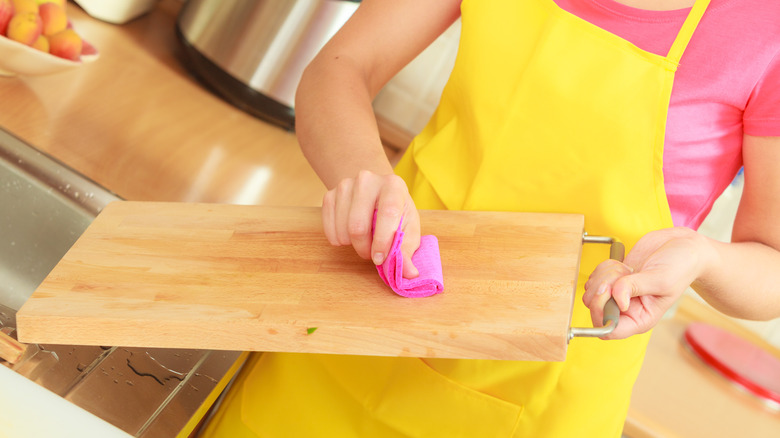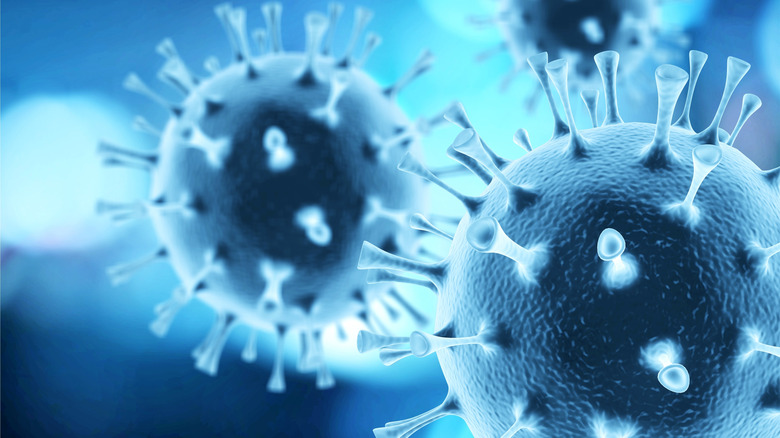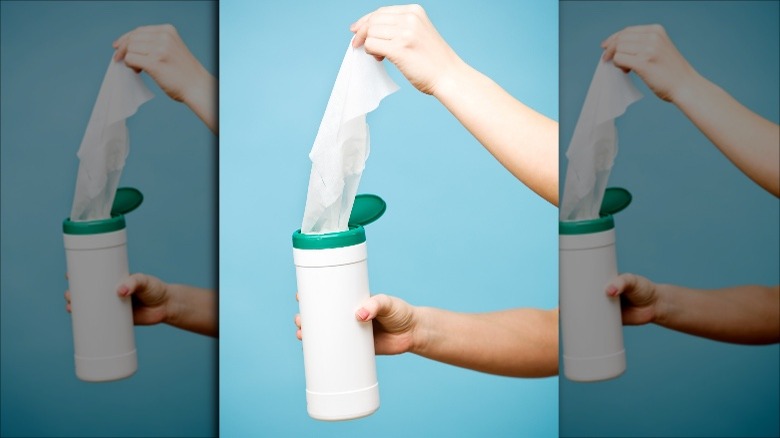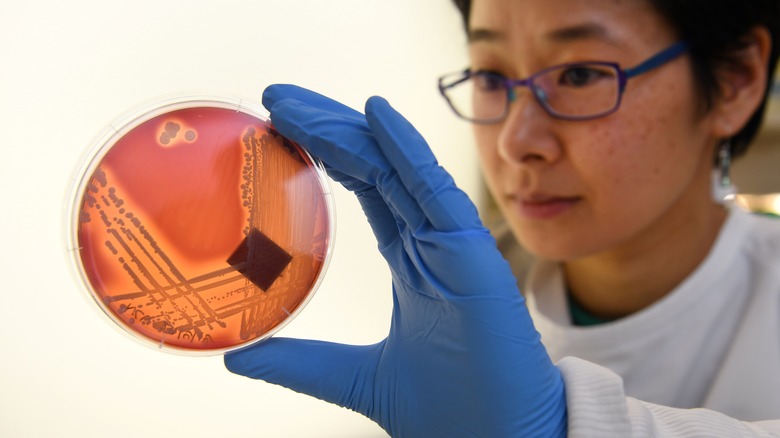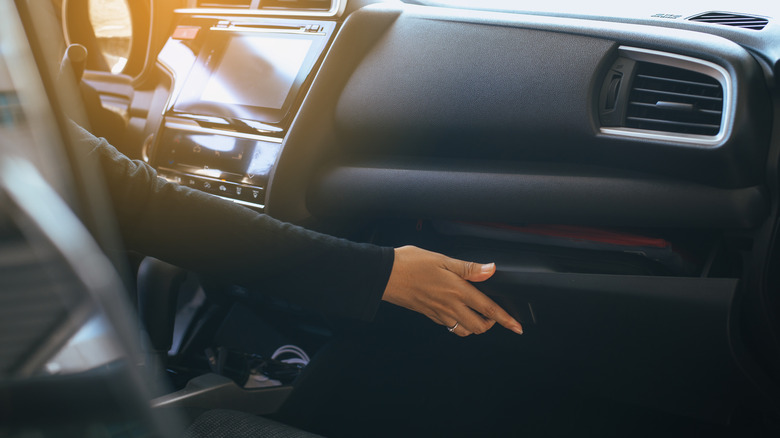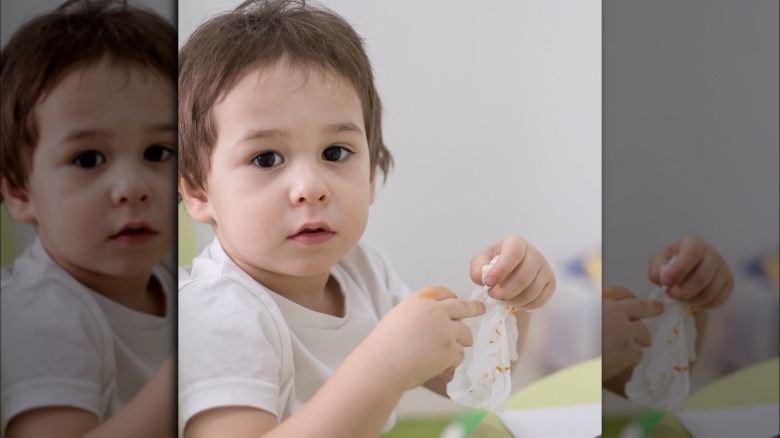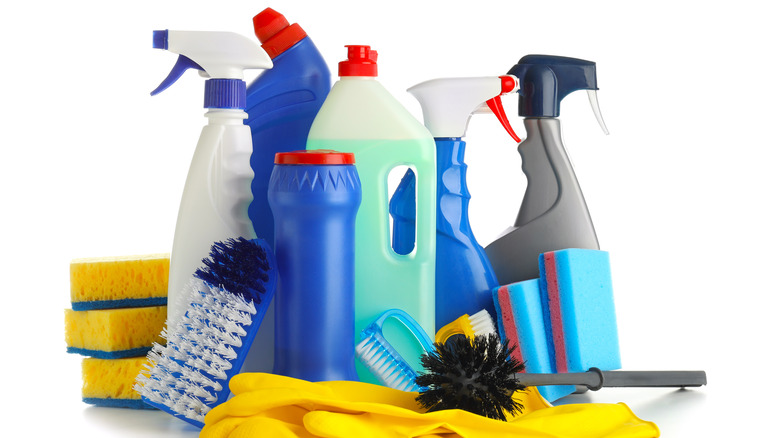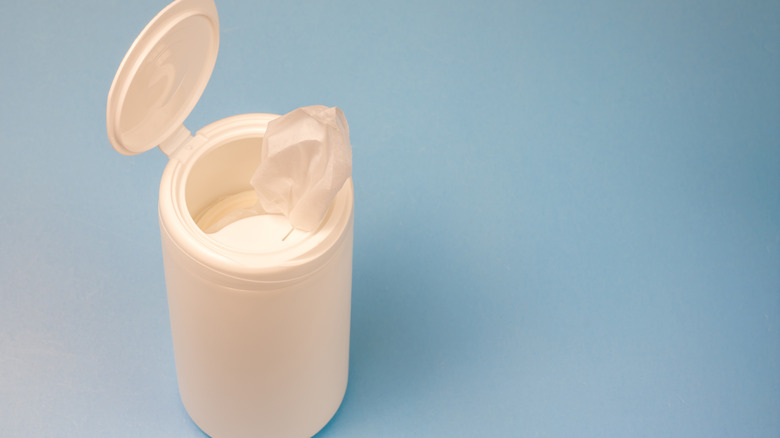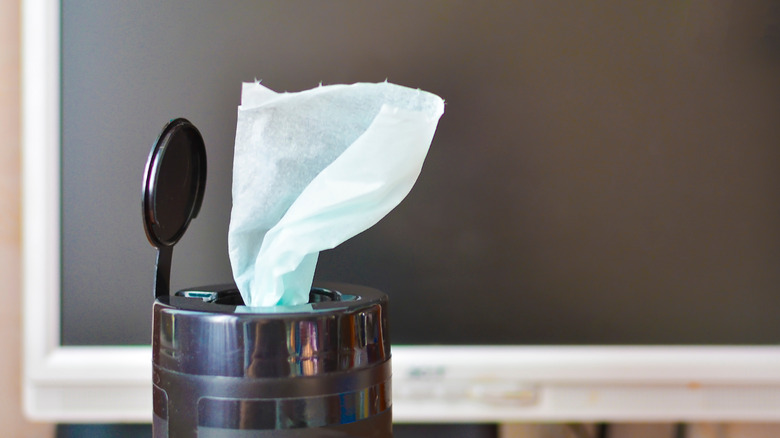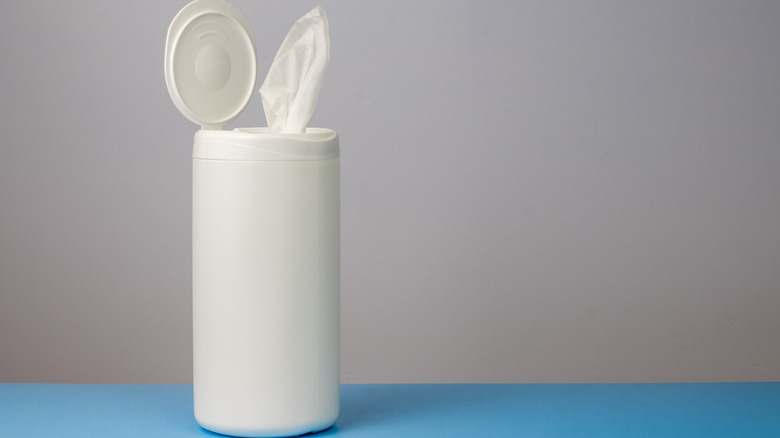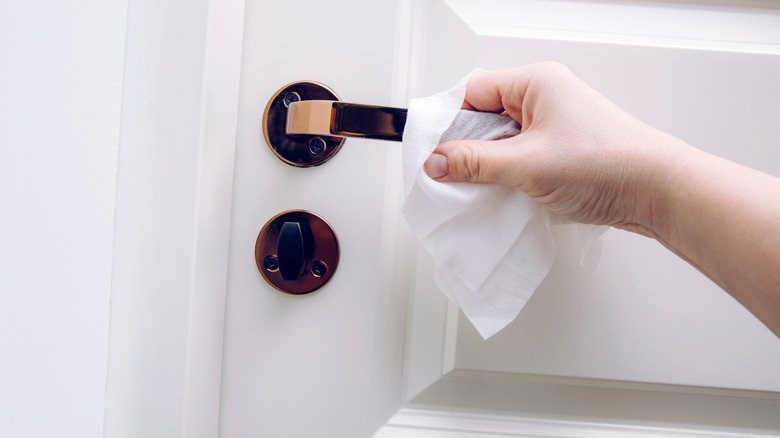Here's The Dirty Truth About Disinfecting Wipes
If you use disinfecting wipes on the regular, you're far from alone. In 2008, the Soap and Detergent Association (SDA) commissioned Echo Research to conduct a cleaning survey across the country. Most Americans — a considerable 71 percent — said they use some form of wipes, according to the results of the survey published in a press release. Of that percentage, 77 percent keep at least two containers in their homes at all times and over a quarter of those people said they whip out a wipe at least once per day. By 2014, Clorox reported (via Environmental Working Group) that roughly half of American homes use their brand of disinfecting wipes.
"Cleaning wipes have become part of the American fabric, so to speak," Brian Sansoni, vice president of communication at SDA, was quoted as saying in the release. "Not only do they help keep us healthy, they do so conveniently and effectively." But do they? Here's the dirty truth about our beloved disinfecting wipes.
What's in a disinfecting wipe?
It's hard to argue against the practicality of disinfecting wipes. According to the Soap and Detergent Association's study (via Infection Control Today), 28 percent of Americans who use either cleaning, disinfecting, or antibacterial wipes do so because of their portability and another 20 percent use them because of the "ease of disposal." Others like them because they are quick and functional. Many like disinfecting wipes, in particular, because of their ability to kill germs.
Disinfecting wipes' germ-fighting abilities are advertised right on the container — and independent studies have confirmed that those claims are accurate. According to one such study published in Journal of Applied Microbiology (via Science Daily), wiping down your kitchen counters with disinfecting wipes after preparing poultry will cut your chance of Campylobacter food poisoning by 99.2 percent.
The ingredients wipes contain are indeed very effective in killing germs, Sampson Davis, an emergency room physician, revealed on The Dr. Oz Show. According to the doctor, water is combined with binding agent sodium C14-17 sec-alkyl sulfonate, essential oils for fragrance, preservatives to prohibit mold and bacteria growth, and, lastly, glycolic acid, which Davis said is "an organic substance" that "helps make the area smooth."
Disinfecting and cleaning are not one in the same
One of the problems with disinfecting wipes doesn't actually have anything to do with the product itself but how we're using them. "The truth is, disinfecting wipes are not necessary for routine cleaning," the Environmental Working Group (EWG) revealed on its site. Although we may lump them together in one category, there is a big difference between cleaning and disinfecting. "While cleaning removes germs from a surface," the EWG explained, "disinfecting kills them by using antimicrobial pesticides, such as quaternary ammonium compounds or 'quats.'"
Before you break out your container of wipes, the EWG stresses the need to recognize whether you actually need to disinfect or you just need to clean. Cleaning regularly will both remove germs that are present and prohibit more germs from appearing. When a surface comes in contact with "raw meat, blood or bodily fluids, and when a family member suffers from a contagious illness, such as the flu," disinfecting is then advised.
Disinfecting wipes can't replace soap and water
The cleaning product industry has been steadily growing. By 2016, the revenue from manufacturing these products was projected to exceed $61 billion in the U.S. It may go without saying that consumers have a lot of cleaning supplies from which to choose. And, as you may very well know, many of these products are marketed to make our lives easier. But, if you're looking for the most effective product, it's not going to be the flashiest in the cleaning aisle. It's not going to be those handy dandy disinfecting wipes either. Because, after all, they are mainly for disinfecting.
"We find that soap and water — good ol' soap and water — never fails us," emergency room physician Sampson Davis revealed on The Dr. Oz Show. Even with so many powerful disinfectants out there, the first line of defense against germs is always going to be soap and water. This is true even of contaminated surfaces that should be disinfected. You should first go in with — you guessed it — soap and water, according to Davis.
You could just be spreading bacteria with disinfecting wipes
Considering that disinfecting wipes are highly effective at killing germs, you might not see the harm in forgoing the soap and water and just doubling down on wipes. However, it is quite literally harmful to do that. Although we're probably all guilty of giving our counters a half-ass wipe-down, you may actually "be spreading the bacteria and the germs versus disinfecting the surface," emergency room physician Sampson Davis explained on The Dr. Oz Show. Obviously, this negates the entire reason for using a disinfecting wipe in the first place.
After cleaning the area with soap and water, you'll need to allow the area to dry. Then, you should take a peek at the instructions on the back of the wipes container. Yes, apparently there are instructions. According to Davis, the label will tell you how long you'll need to keep the surface area wet for it to be properly disinfected. This means you may have to disinfect an area for as long as "four to ten minutes." Unfortunately, those 15-second swishes could be doing more harm than good.
You'll probably need to use more than one disinfecting wipe
The label of your preferred disinfecting wipes also tells you — albeit in small print — how long you are to keep a surface area wet. Ivan Ong, a microbiologist and vice president of research and development at Microban, told Apartment Therapy, "For example, the use instructions for Clorox's disinfecting wipes stipulates that you should 'Wipe surface, using enough wipes for the treated surface to remain visibly wet for four minutes. Let surface dry.'" Did you catch that? You have to use enough wipes for the area to stay wet. Often times, that means you're going to need more than one measly wipe.
Since "many users in a household rarely time themselves for four minutes while ensuring the surface is wet," according to the expert, we all risk just spreading germs around. Sigh. It's time to start following the instructions. William Schaffner, department chair of preventative medicine at Vanderbilt University School of Medicine, further recommended having a "use it and lose it" philosophy when disinfecting with wipes. Before moving on to a new area, throw the wipe away and reach for a new one.
Could disinfecting wipes lead to superbugs?
Alright, so now you know the right way to use disinfecting wipes. To be safe, we can just use a ton of wipes and scrub down every surface scrupulously, right? Well, no. That carries with it its own problems. Not all bacteria is bad, but disinfecting wipes work to indiscriminately kill bacteria as a whole: bad and good. Additionally, overusing disinfectants like wipes can lead to the growth of antibiotic-resistant bacteria known as "superbugs," the Environmental Working Group revealed.
In 2008, British researchers also discovered that one particular kind of superbug, methicillin-resistant Staphylococcus aureus (aka MRSA), was able to be spread through disinfecting wipes — the very product meant to eliminate harmful bacteria. "What we have found is there is a high risk," Gareth Williams, a microbiologist at Cardiff University, told Reuters.
All hope is not lost, though. He, like Vanderbilt University School of Medicine's department chair of preventative medicine William Schaffner, recommended a similar "use it and lose it" procedure. He explained, "We found that the most effective way to prevent the risk of MRSA spread in hospital wards is to ensure the wipe is used only once on one surface."
No, you can't keep disinfecting wipes in your car
"From purses and car consoles to countertops and suitcases, there is a wipe where and when we need it," Brian Sansoni, Soap and Detergent Association's vice president of communication, revealed in a press release. While these may be common places to stash the product, not all of these locations are actually suitable for disinfecting wipes.
On The Dr. Oz Show, emergency room physician Sampson Davis said "storage [of the wipes] is very important." He continued, saying, "You want to make sure you store it at room temperature. Sometimes we keep our wipes in our car, we keep some all over the place. And if it's a place in extreme heat or extreme cold, what happens is you destroy the preservatives and you may get 'fold mold.'" As the name implies, it's a fungus that develops in between the folds of the wipes. Imagine spreading that around all over your steering wheel! Eek.
Disinfect, rinse, repeat
You might not think much of giving your little one's toys a wipe-down with a disinfecting wipe, but there are some guidelines to keep in mind when using the germ-killing agent in this way. According to Lysol's website, small plastic toys without batteries can be both cleaned and sanitized with a trip through the dishwasher. For little plastic toys with batteries, the company recommends cleaning the outer areas of the toy with soap and warm water and then using a wipe to disinfect the outside. Yes, Lysol's wipes are safe enough to use on your children's toys. However, you'll need to "wipe the toy with water and dry before handing the toy back to baby," according to the brand.
Depending on the toy, larger plastic toys can also be disinfected in the same manner. When it comes to fabric toys like stuffed animals, though, you're going to want to wash them as you would clothing. Disinfecting wipes won't do much good there.
Disinfecting wipes are not safe for children
When used properly, disinfecting wipes can be safe enough to use on children's toys. Nevertheless, disinfecting wipes come with a "keep out of reach of children" warning on the front of every container. Of course, not everyone heeds the warning.
One parent in Massachusetts became concerned after discovering that his daughter and other students at Huckleberry Hill School, one of Lynnfield's public schools, were being given Clorox wipes to clean their desks and tables.
The parent's attorney, Nicholas Di Mauro, told WBZ (via CBS Boston), "Children should not be exposed to any of these chemicals. This is a serious safety issue in my client's opinion." Di Mauro filed a complaint with the Department of Agricultural Resources, which resulted in a pesticide inspector issuing a "letter of warning" to Lynnfield Public Schools. The letter demanded the school "cease and desist having children use products that have 'Keep out of reach of children' on the label." While encouraging kids to clean is a great idea, disinfecting wipes are not fit for the task.
You'll need more than disinfecting wipes to clean your bathroom
Disinfecting wipes can be a welcome addition in helping you keep your bathroom sanitary. However, they're not the only product you should use because, remember, they're made mostly for disinfecting. Lysol recommends you use their wipes for "quick and convenient cleaning" like wiping down "sinks, tiles, toilet seats, bathtubs, trash cans and the bathroom floor." These wipe-downs are meant to, according to the brand, "save you a lot of time when it comes to deep bathroom cleaning."
This is true of other name-brand disinfecting wipes, like Clorox disinfecting wipes. Although the label is known for its bleach-based products, there's no bleach in their disinfecting wipes, a brand representative confirmed to Apartment Therapy. As such, don't expect Clorox wipes to work like bleach.
As much as we wish disinfecting wipes were the holy grail of cleaning, they are unfortunately not. The wipes may buy you a little time between deeper cleanings, but you'll still need to whip out the toilet bowl cleaner and shower scrubber on a regular basis.
Disinfecting wipes won't stay good forever
Storing your disinfecting wipes in a cool, dry place may ward off "fold mold," but you shouldn't expect the wipes to stay fresh forever. The product will start to degrade after two years, and, according to Good Housekeeping, the wipes may then begin to "lose some of their effectiveness." If you crack open a container of mystery disinfecting wipes, the smell will tell you all you need to know. If the scent is weaker than you remember, you should toss them out. Since the purpose of the product is to disinfect and kill germs, it's not worth the risk of using old wipes to do the job. Instead, buy a new container that you know is going to have that near-100 percent guarantee.
Still, disinfecting wipes don't exactly expire, per se. A representative for Lysol revealed on Facebook that their products do not have an expiration date, but rather have "a shelf life of two years from date of manufacture." The same is true of Clorox products. However, Clorox assigns an even shorter shelf-life — one year — to their wipes.
Disinfecting wipes are not meant for your skin
Disinfecting wipes are not the same as antibacterial wipes — nor should they be used in the same manner. On their site, Clorox states that their wipes "should not be used for personal cleansing." They are not to be used as baby wipes, either. Furthermore, disinfecting wipes can cause eye irritation — as is indicated on the label. And, as such, Clorox advises users to "avoid contact with eyes" and "wash thoroughly with soap and water after handling." Likewise, the Environmental Working Group cautions consumers not to use the product on their skin.
Just because disinfecting wipes can kill the germs lurking on your kitchen and bathroom counters, it doesn't mean it will do the same for your hands. Mary Gagliardi, a cleaning expert at Clorox, told Apartment Therapy that the product's disinfecting claims are solely based on the wipes' interaction with hard and soft surfaces — not skin.
Don't use disinfecting wipes on every surface
Although disinfecting wipes have been tested on surfaces, they shouldn't be used on every surface. Mary Gagliardi, a cleaning expert at Clorox, told Apartment Therapy that the wipes shouldn't be used on absorbent surfaces like rugs or carpeting. They also shouldn't be used to disinfect unpainted wood because it, too, is absorbent. Likewise, this rule also applies to any surfaces that are unsealed, unfinished, or even oiled or waxed. Clorox disinfecting wipes should also not be used on copper, aluminum, or polished surfaces.
Before you disinfect a surface, it pays to check the label to see what can be safely sanitized. And, when in doubt, the cleaning expert said you should test a small surface area before you set about tackling an entire space with disinfecting wipes.
Of course, you don't have to use these wipes at all. The Environmental Working Group said diaper wipes are made without the chemicals in disinfecting wipes and yet are still a viable option for "routine cleaning" of "hard surfaces." Plus, they're safe for your hands.
There are serious benefits to using disinfecting wipes
Although disinfecting wipes may not be the miracle product you once thought they were, there are still proven benefits to using them. Clorox disinfecting wipes advertise the ability to kill 99.9 percent of "germs that can live on surfaces for up to 48 hours" as well as bacteria and viruses that cause the common cold and the flu. When used correctly, disinfecting wipes can also kill E. coli, salmonella, and strep.
The Centers for Disease Control and Prevention recognizes their place in quelling germs in schools and advises using the wipes on phones, computers, and any other "electronic items that are touched often" and "can withstand the use of liquids for cleaning and disinfecting."
In 2014, researchers conducted a study comparing cleaning and disinfecting wipes to a "towel and bucket method." The results? "When using ready-to-use wipes, we found compliance to be significantly higher, a more rapid cleaning and disinfection process, and potential cost savings," the study revealed. The researchers concluded the abstract by urging facilities to consider supplying these easy-to-use wipes. Whether you choose to use disinfecting wipes in your home, though, is entirely up to you.
Are disinfecting wipes any match for a pandemic?
In response to the global outbreak of the novel coronavirus, aka COVID-19, the American Chemistry Council's Center for Biocide Chemistries released a list of products approved by the United States Environmental Protection Agency (EPA) "for use against emerging enveloped viral pathogens." Thankfully, several disinfecting wipes, including Clorox Disinfecting Wipes and Purell Professional Surface Disinfectant Wipes, made the cut. However, these wipes should not, under any circumstances, be thought of as a substitute for other hygienic practices like proper hand-washing.
"Using the correct disinfectant is an important part of preventing and reducing the spread of illnesses along with other critical aspects such as hand washing," EPA administrator Andrew Wheeler explained in a statement provided to CNN Health.
Per the Centers for Disease Control and Prevention's "Clean & Disinfect" coronavirus guide, COVID-19 may remain on surfaces for as long as hours to days. Thus, the need for disinfecting. The CDC further advises both frequent cleaning and disinfecting to prevent against the coronavirus. Surfaces that are visibly dirty should be first cleaned with soap and water and then disinfected.
How to use disinfecting wipes during a pandemic
To protect against the coronavirus, the Centers for Disease Control and Prevention advises disinfecting frequently touched surfaces, including "tables, doorknobs, light switches, countertops, handles, desks, phones, keyboards, toilets, faucets, and sinks" every day.
However, in order for disinfecting wipes to be useful against COVID-19, they must be used correctly. Brian Sansoni of the American Cleaning Institute explained to Chemical & Engineering News that wiping the disinfectant off too early may be useful for cleaning, but it won't adequately sanitize the surface. To know exactly how long to let the disinfectant sit, check the wipes container and follow the instructions to a T. You shouldn't assume you know how to use, say, Purell wipes because you've used Lysol ones in the past. "Each disinfectant product — be it a spray or wipe, for instance — is formulated differently," Sansoni explained. Those different formulas mean they may take more or less time than another product to thoroughly disinfect.
As long as you allow disinfecting wipes time to do their thing, though, they're really great. Charles Gerba, a microbiologist at the University of Arizona, further told the publication the wipes "win hands-down" compared to disinfecting sprays because people aren't as likely to wipe off the product prematurely.


